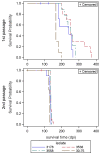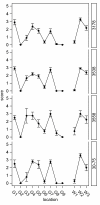Transmissibility of caprine scrapie in ovine transgenic mice
- PMID: 22472560
- PMCID: PMC3489715
- DOI: 10.1186/1746-6148-8-42
Transmissibility of caprine scrapie in ovine transgenic mice
Abstract
Background: The United States control program for classical ovine scrapie is based in part on the finding that infection is typically spread through exposure to shed placentas from infected ewes. Transmission from goats to sheep is less well described. A suitable rodent model for examining the effect of caprine scrapie isolates in the ovine host will be useful in the ovine scrapie eradication effort. In this study, we describe the incubation time, brain lesion profile, glycoform pattern and PrPSc distribution patterns in a well characterized transgenic mouse line (Tg338) expressing the ovine VRQ prion allele, following inoculation with brain from scrapie infected goats.
Results: First passage incubation times of caprine tissue in Tg338 ovinized mice varied widely but second passage intervals were shorter and consistent. Vacuolation profiles, glycoform patterns and paraffin-embedded tissue blots from terminally ill second passage mice derived from sheep or goat inocula were similar. Proteinase K digestion products of murine tissue were slightly smaller than the original ruminant inocula, a finding consistent with passage of several ovine strains in previous reports.
Conclusions: These findings demonstrate that Tg338 mice propagate prions of caprine origin and provide a suitable baseline for examination of samples identified in the expanded US caprine scrapie surveillance program.
Figures







Similar articles
-
Molecular and transmission characteristics of primary-passaged ovine scrapie isolates in conventional and ovine PrP transgenic mice.J Virol. 2008 Nov;82(22):11197-207. doi: 10.1128/JVI.01454-08. Epub 2008 Sep 3. J Virol. 2008. PMID: 18768980 Free PMC article.
-
Propagation of ovine prions from "poor" transmitter scrapie isolates in ovine PrP transgenic mice.Exp Mol Pathol. 2012 Feb;92(1):167-74. doi: 10.1016/j.yexmp.2011.11.004. Epub 2011 Nov 19. Exp Mol Pathol. 2012. PMID: 22120785
-
A transfectant RK13 cell line permissive to classical caprine scrapie prion propagation.Prion. 2016 Mar 3;10(2):153-64. doi: 10.1080/19336896.2016.1166324. Prion. 2016. PMID: 27216989 Free PMC article.
-
Genetic and infectious prion diseases.Arch Neurol. 1993 Nov;50(11):1129-53. doi: 10.1001/archneur.1993.00540110011002. Arch Neurol. 1993. PMID: 8105771 Review.
-
Prion encephalopathies of animals and humans.Dev Biol Stand. 1993;80:31-44. Dev Biol Stand. 1993. PMID: 8270114 Review.
Cited by
-
Accumulation profiles of PrP(Sc) in hemal nodes of naturally and experimentally scrapie-infected sheep.BMC Vet Res. 2013 Apr 19;9:82. doi: 10.1186/1746-6148-9-82. BMC Vet Res. 2013. PMID: 23601183 Free PMC article.
-
Classical natural ovine scrapie prions detected in practical volumes of blood by lamb and transgenic mouse bioassays.J Vet Sci. 2015;16(2):179-86. doi: 10.4142/jvs.2015.16.2.179. Epub 2014 Dec 24. J Vet Sci. 2015. PMID: 25549221 Free PMC article.
-
PrPres in placental tissue following experimental transmission of atypical scrapie in ARR/ARR sheep is not infectious by Tg338 mouse bioassay.PLoS One. 2022 Jan 21;17(1):e0262766. doi: 10.1371/journal.pone.0262766. eCollection 2022. PLoS One. 2022. PMID: 35061802 Free PMC article.
-
Sensitive and specific detection of classical scrapie prions in the brains of goats by real-time quaking-induced conversion.J Gen Virol. 2016 Mar;97(3):803-812. doi: 10.1099/jgv.0.000367. Epub 2015 Dec 10. J Gen Virol. 2016. PMID: 26653410 Free PMC article.
-
Role of the PRNP S127 allele in experimental infection of goats with classical caprine scrapie.Anim Genet. 2015 Jun;46(3):341. doi: 10.1111/age.12291. Anim Genet. 2015. PMID: 25917307 Free PMC article. No abstract available.
References
Publication types
MeSH terms
Substances
LinkOut - more resources
Full Text Sources

